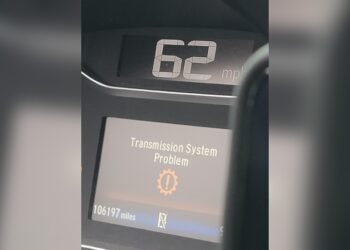A car battery may show voltage without delivering amps due to internal damage or corrosion. This indicates an inability to provide the necessary current to start the car.
Understanding the health of your car battery is crucial for reliable vehicle operation. Voltage alone can be misleading; it’s the amperage that really tells you if the battery has the power to turn over the engine. Car batteries can fail for several reasons, including age, temperature extremes, and prolonged lack of use.
Regular checks can prevent unexpected breakdowns and ensure your vehicle is ready when you need it. A battery may have enough voltage to power lights and accessories, yet lack the amps needed for ignition, highlighting the importance of a comprehensive battery test. Keep your car’s performance optimal by ensuring the battery is both fully charged and capable of delivering the necessary current.
Introduction To Car Battery Issues
A car battery is essential for starting your vehicle. Sometimes, a battery may show voltage but not deliver the current needed. This can be confusing and frustrating. Let’s explore this issue.
The Mystery Of Voltage Without Current
Voltage is like pressure from stored energy. Current (amps) is the flow of this energy. A battery might show enough voltage but fail to supply current. This is a sign of a deeper problem.
Symptoms Of A Non-functional Car Battery
- Engine won’t start – The starter motor needs current to turn over.
- Lights are dim or flickering – Lights need a steady current supply.
- Electrical issues – Radios and other systems may not work properly.
The Role Of Voltage And Amperage
Understanding the role of voltage and amperage helps diagnose car battery issues. Both play crucial roles in a battery’s performance. Let’s explore why a car battery might have voltage but no amps.
Voltage Vs. Current: What’s The Difference?
Voltage is the force that pushes electrical energy through a circuit. Think of it like water pressure in a hose. Current, or amperage, is the flow of electrical energy. It’s similar to the water flowing through that hose. A battery might show voltage, meaning it has the potential to push energy. But without amps, there’s no actual flow of power.
- Voltage is like pressure.
- Current is like flow.
Why Both Voltage And Current Matter
A car battery needs both voltage and current to work well. Voltage gets the electrical system going. Current powers the car’s accessories and starts the engine. A battery with voltage but no amps cannot start a car. It’s like having a hose with pressure but no water flow.
| Component | Role |
|---|---|
| Voltage | Starts electrical system |
| Current | Powers accessories and engine |
A healthy battery needs both. This balance ensures your car runs smoothly.
Common Causes For Voltage-only Situations
Car batteries can show voltage without supplying amps. This issue often confuses car owners. A battery might seem fine when tested with a voltmeter, but it won’t start the car. Let’s explore common reasons for voltage-only situations in car batteries.
Corroded Battery Terminals
Corrosion on battery terminals is a leading cause. It disrupts current flow. This can trick you into thinking your battery is charged. It’s not. A visual check often reveals a white or greenish substance.
- Clean terminals restore current flow.
- Regular maintenance prevents corrosion.
Internal Battery Damage
Damage inside your battery can cause issues. A drop or accident might harm it. Plates inside can break or short-circuit. This damage stops the amps but not the voltage.
| Signs of Damage | What to Do |
|---|---|
| Battery leaks | Replace the battery |
| Battery case bulges | Get a professional check |
| Odd smells | Check for internal faults |
Initial Diagnostic Steps
When a car battery shows voltage but no amps, it’s puzzling. Your car won’t start. Let’s diagnose this issue with some easy steps.
Performing A Visual Inspection
Start with the simplest check: a visual inspection. Look for signs of damage or corrosion. Check battery terminals. Are they clean and tight? Corrosion can block current flow. Clean any powdery residue with a brush. Make sure cables connect well.
Testing Battery With A Multimeter
Next, test the battery with a multimeter. Set the multimeter to measure voltage. Connect the red lead to the positive terminal. Attach the black lead to the negative terminal. A good battery should show around 12.6 volts. Now, switch the multimeter to measure amps. Test the battery again. No amps may mean a dead cell. A professional test may be needed.
Remember: safety first. Wear protective gear. A faulty battery can be dangerous. Follow these steps to find the issue. A healthy car battery is key to a reliable car.
Advanced Troubleshooting Techniques
Let’s dive into Advanced Troubleshooting Techniques for a car battery issue. Sometimes, a battery shows voltage but no amps. This means the battery can’t power your car. We’ll learn two key ways to fix this.
Conducting A Load Test
A load test checks if the battery can hold charge under use. Follow these steps:
- Turn off your car and all lights.
- Connect a load tester to the battery.
- Read the tester’s manual to use it right.
- Watch the load tester’s reading. A good battery won’t drop below 9.6 volts.
If the voltage drops too low, the battery may need replacing.
Checking The Charging System
The charging system keeps the battery charged. To check it:
- Start the car.
- Use a voltmeter on the battery terminals.
- A healthy system shows 13.7 to 14.7 volts.
If readings are off, the alternator or related parts might be bad.
These steps help find and fix battery power issues. A pro can help if you’re stuck.

Credit: www.reddit.com
Repair Or Replace: Making The Right Decision
Car owners often face a common dilemma: repair or replace a battery. A battery with voltage but no amps can be tricky. This guide will help you decide.
When To Clean And Reconnect
Simple steps can sometimes restore battery function. Look for these signs:
- Corrosion on terminals
- Loose connections
- Dirty battery case
Follow these steps:
- Turn off your car
- Disconnect battery cables
- Clean terminals with a brush
- Reconnect and tighten cables
This might fix the issue. If not, consider a replacement.
Signs You Need A New Battery
A battery beyond repair shows clear signs:
- Slow engine crank
- Dim lights and weak horn
- Swollen battery case
- Old age (over 3-5 years)
Don’t wait for a breakdown. Replace your battery when you see these signs.
Remember: Regular checks save time and money. Act early to avoid trouble.
Preventive Measures To Avoid Future Issues
A car battery might show voltage without sufficient amps to start the engine. This can lead to unexpected breakdowns. To prevent such issues, regular checks and correct battery choices are vital.
Regular Maintenance Tips
Regular battery maintenance ensures longevity and reliability. Follow these tips:
- Clean the terminals to prevent corrosion.
- Check the electrolyte level and top up if needed.
- Inspect the battery case for damage or leaks.
- Test the battery’s charge every six months.
- Secure the battery to avoid vibrations.
Choosing The Right Replacement Battery
Selecting the correct battery is essential. Consider these points:
| Feature | Importance |
|---|---|
| Battery Size | Must fit the car’s battery tray. |
| Power Requirement | Meets or exceeds the OEM specs. |
| Warranty | Offers good coverage for defects. |
| Brand Reputation | Choose reliable manufacturers. |
Always buy batteries from reputable brands. Check the warranty and ensure it fits your vehicle’s specifications.

Credit: www.youtube.com
Professional Help Vs. Diy
When your car battery shows voltage but not amps, it’s confusing. This issue needs fixing to start your car. You might wonder whether to call a mechanic or fix it yourself. Both options have pros and cons. Let’s explore when to seek professional help and how to DIY troubleshoot.
When To Call A Mechanic
- No experience: If you lack electrical knowledge, a mechanic is safer.
- Warranty: Some batteries have warranties. Check yours before doing anything.
- Complex issues: Mechanics have tools to diagnose deeper problems.
- Time: If you need a quick fix, professionals can help faster.
Resources For Diy Troubleshooting
For those who prefer DIY, start with the right information. Here’s how:
- Manuals: Your car manual has specific battery info.
- Online forums: Car enthusiasts share tips and solutions.
- Videos: Watch tutorials for step-by-step guides.
- Toolkits: Ensure you have a multimeter and safety gear.
Check connections and clean corrosion first. Test the battery with a multimeter. If the issue persists, consult more detailed resources or consider professional help.

Credit: www.reddit.com
Frequently Asked Questions
Why Won’t My Car Battery Deliver Amps?
A car battery may have voltage but fail to deliver amps due to a damaged cell, poor connections, or a sulfated battery plate, which prevents proper current flow.
Can A Dead Battery Still Show Voltage?
Yes, a dead battery can display voltage without the capacity to provide sufficient current (amps) for starting the engine or powering electrical components.
What Does Voltage With No Amps Indicate?
Voltage with no amps typically indicates a battery has charge but lacks the ability to release energy, often due to internal faults or external connection issues.
How To Test A Battery For Amps Output?
Use a multimeter in ammeter mode or a dedicated load tester to measure the battery’s amp output under load, ensuring it meets the manufacturer’s specified rating.
What Causes A Battery To Lose Amperage?
Loss of amperage can be caused by internal degradation, such as sulfation, damaged plates, or loss of electrolyte, and also by external factors like corroded terminals.
Conclusion
Understanding your car battery’s issue of having voltage but no amps is crucial. This insight not only aids in troubleshooting but also ensures your vehicle’s reliability. Remember, regular maintenance and prompt attention to such signs can prevent bigger problems. Keep your journey smooth by staying informed and proactive about your car’s electrical health.
















